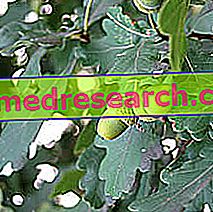
Scientific name
Quercus robur
Family
Fagaceae
Origin
Europe
Synonyms
English Oak
Used Parts
Drug consisting of the bark of young branches
Chemical constituents
- procyanidins;
- Catechins;
- Tannins (gallotannins and ellagitannins).
Oak in Herbalist: Properties of the Oak
The oak can be used under medical prescription for its disinfectant and anti-inflammatory activity in the treatment of diarrhea (decoction or capsules).
Biological activity
The oak, thanks to the tannins contained within its bark, is able to exert an astringent, anti-inflammatory, anthelmintic, antiviral and disinfectant action.
Thanks to its marked astringent action, the oak is used internally for the treatment of diarrhea (a use that has been officially approved).
Furthermore, the extract of oak taken internally in small doses is used as a stomachic remedy to favor, therefore, a correct digestion, although this use has not been approved.
Oak against diarrhea
As stated above, thanks to the astringent and disinfectant activity conferred by the tannins, the oak can be used as a remedy to combat non-specific diarrhea.
For the treatment of this disorder, the oak must be used internally and is usually taken in the form of a decoction.
Usually, it is recommended to take two or three cups of decoction per day (freshly prepared each time, soaking 1 gram of drug in cold water and then quickly bringing it to boiling). The maximum recommended dose is 3 grams of drug per day.
Oak against skin and oropharyngeal inflammation
The anti-inflammatory and astringent activities exercised by the oak are not only useful at the gastrointestinal level, but are equally effective at the level of the skin and mucous membranes. Therefore, this plant is a valid aid in the treatment of inflammations of the skin and mucous membranes of the mouth and pharynx.
For the treatment of the aforementioned diseases, the oak is used externally, generally in the form of a solution for rinsing and gargling. This solution can be prepared by boiling two teaspoons of finely divided drug in about three cups of water.
Oak in folk medicine and homeopathy
The properties of oak have long been known in folk medicine. In fact, this plant is used both internally and externally in the treatment of various disorders.
More precisely, traditional medicine involves the internal use of the oak for the treatment of chronic inflammation of the gastrointestinal tract and as a remedy against blood in the stool, against hemoptysis and against uterine bleeding (non-menstrual).
Externally, however, oak is used by folk medicine to treat ailments such as hemorrhoids, inflammation of the genital and anal areas, varicose veins, eczema and eye inflammation.
Furthermore, oak is also used in homeopathic medicine. It is readily available in the form of globules, oral drops or mother tincture, with indications for the treatment of disorders such as rheumatism, lumbago and contractures of the shoulders and neck.
The amount of remedy to be taken can vary from individual to individual, also depending on the type of preparation and the type of homeopathic dilution you intend to use.
Side effects
Occasionally, when the oak is taken internally, small digestive problems may occur due to the astringent action exerted by the tannin component.
Contraindications
Avoid taking oak in case of hypersensitivity to one or more components.
Pharmacological Interactions
- reduction of the absorption of alkaloids and other basic drugs;
- iron: tannins precipitate iron salts.



